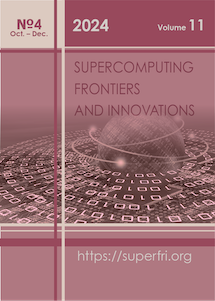HPC Optimization Algorithm for Assessing Haemodynamic Parameters in Synthetic Patient Cohorts
DOI:
https://doi.org/10.14529/jsfi240408Keywords:
Unscented Kalman Filter, hemodynamic model, inverse problem, synthetic data base, virtual population, parallel computing, high-performance computingAbstract
A computational framework for the generation of a synthetic pulse wave database is developed. This framework demonstrates the feasibility of generating large-scale, high-fidelity virtual patient cohorts for biomedical research. Pulse waves are generated using a one-dimensional hemodynamic model of the systemic circulation coupled with a model of the left heart. Each virtual patient in the database is defined by a set of physiological parameters, including systolic and diastolic blood pressure, stroke volume, and heart rate. The parameters are optimized to match the desired outputs by solving an inverse problem using the Unscented Kalman Filter (UKF). The UKF is selected for its ability to accurately and efficiently estimate parameters in nonlinear systems. The generation of a single virtual patient requires between one and several hundred iterations of the UKF, depending on the complexity of the desired outputs. To meet the computational demands of generating a database with thousands of virtual patients, a computing cluster with 24 CPU nodes, each containing 52 cores, is employed. Two levels of parallelization are implemented, resulting in a speedup factor of 8.
References
Abohtyra, R.M., Vincent, T.L.: Nonlinear parameter and state estimation approach in end-stage kidney disease patients. bioRxiv (2023). https://doi.org/10.1101/2022.04.02.486844
Allen, R.J., Rieger, T.R., Musante, C.J.: Efficient generation and selection of virtual populations in quantitative systems pharmacology models. CPT Pharmacometrics Syst Pharmacol 5(3), 140–146 (2016). https://doi.org/10.1002/psp4.12063
Arthurs, C., Xiao, N., Moireau, P., et al.: A flexible framework for sequential estimation of model parameters in computational hemodynamics. Advances in Modeling and Simulation in Engineering Sciences 7, 48 (2020). https://doi.org/10.1186/s40323-020-00186-x
Bertoglio, C., Moireau, P., Gerbeau, J.F.: Sequential parameter estimation for fluidstructure problems: Application to hemodynamics. International Journal for Numerical Methods in Biomedical Engineering 28(4), 434–455 (2012). https://doi.org/10.1002/cnm.1476
Boileau, E., Nithiarasu, P., Blanco, P.J., et al.: A benchmark study of numerical schemes for one-dimensional arterial blood flow modelling. International Journal for Numerical Methods in Biomedical Engineering 31(10) (2015). https://doi.org/10.1002/cnm.2732
Caiazzo, A., Caforio, F., Montecinos, G., et al.: Assessment of reduced-order unscented Kalman filter for parameter identification in 1-dimensional blood flow models using experimental data. International Journal for Numerical Methods in Biomedical Engineering 33(8), e2843 (2017). https://doi.org/10.1002/cnm.2843
Charlton, P.H., Harana, J.M., Vennin, S., et al.: Modeling arterial pulse waves in healthy aging: a database for in silico evaluation of hemodynamics and pulse wave indexes. American Journal of Physiology - Heart and Circulatory Physiology 317(5), H1062–H1085 (2019). https://doi.org/10.1152/ajpheart.00218.2019
Frazier, P.I.: A tutorial on bayesian optimization (2018)
Gamilov, T., Danilov, A., Chomakhidze, P., et al.: Computational analysis of hemodynamic indices in multivessel coronary artery disease in the presence of myocardial perfusion dysfunction. Computation 12(6) (2024). https://doi.org/10.3390/computation12060110
Garay, J., Dunstan, J., Uribe, S., Costabal, F.: Physics-informed neural networks for blood flow inverse problems (08 2023). https://doi.org/10.48550/arXiv.2308.00927
Hall, K.: Predicting metabolic adaptation, body weight change, and energy intake in humans. Am J Physiol Endocrinol Metab 298(3), E449–66 (2009). https://doi.org/10.1152/ajpendo.00559.2009
Hickson, S.S., Butlin, M., Graves, M., et al.: The relationship of age with regional aortic stiffness and diameter. JACC.Cardiovascular Imaging 3(12), 1247–1255 (2010). https://doi.org/10.1016/j.jcmg.2010.09.016
Jeanson, F., Farkouh, M.E., Godoy, L.C., et al.: Medical calculators derived synthetic cohorts: a novel method for generating synthetic patient data. Scientific Reports 14, 11437 (2024). https://doi.org/10.1038/s41598-024-61721-z
Khorchani, T., Gadiya, Y., Witt, G., et al.: SASC: A simple approach to synthetic cohorts for generating longitudinal observational patient cohorts from COVID-19 clinical data. Patterns (N Y) 3(4), 100453 (2022). https://doi.org/10.1016/j.patter.2022.100453
Korakianitis, T., Shi, Y.: A concentrated parameter model for the human cardiovascular system including heart valve dynamics and atrioventricular interaction. Medical Engineering & Physics 28(7), 613–628 (2006). https://doi.org/10.1016/j.medengphy.2005.10.004
Korakianitis, T., Shi, Y.: Numerical simulation of cardiovascular dynamics with healthy and diseased heart valves. Journal of Biomechanics 39(11), 1964–1982 (2006). https://doi.org/10.1016/j.jbiomech.2005.06.016
Moireau, P., Chapelle, D.: Reduced-order Unscented Kalman Filtering with application to parameter identification in large-dimensional systems. ESAIM: Control, Optimisation and Calculus of Variations 17(2), 380–405 (2011). https://doi.org/10.1051/cocv/2010006
Nolte, D., Bertoglio, C.: Inverse problems in blood flow modeling: A review. International Journal for Numerical Methods in Biomedical Engineering 38(8), e3613 (2022). https://doi.org/10.1002/cnm.3613
Rammah Abohtyra, T.V., Schneditz, D.: Magnitude and precision of absolute blood volume estimated during hemodialysis. Renal Failure 46(2), 2377781 (2024). https://doi.org/10.1080/0886022X.2024.2377781
Simakov, S., Gamilov, T., Soe, Y.N.: Computational study of blood flow in lower extremities under intense physical load. Russian Journal of Numerical Analysis and Mathematical Modelling 28(5), 485–504 (2013). https://doi.org/10.1515/rnam-2013-0027
Simakov, S., Timofeev, A., Gamilov, T., et al.: Analysis of the impact of left ventricular assist devices on the systemic circulation. Russian Journal of Numerical Analysis and Mathematical Modelling 35(5), 295–314 (2020). https://doi.org/10.1515/rnam-2020-0025
Stamler, J., Stamler, R., Neaton, J.D.: Blood pressure, systolic, and diastolic, and cardiovascular risks: Us population data. Archives of Internal Medicine 153, 598–615 (1993). https://doi.org/10.1001/archinte.153.5.598
Wan, E.A., Merwe, R.V.D.: The unscented Kalman filter for nonlinear estimation. In: Proceedings of the IEEE 2000 Adaptive Systems for Signal Processing, Communications, and Control Symposium (Cat. No.00EX373). pp. 153–158. Lake Louise, AB, Canada (2000). https://doi.org/10.1109/ASSPCC.2000.882463
Wang, T., Jin, W., Liang, F., Alastruey, J.: Machine learning-based pulse wave analysis for early detection of abdominal aortic aneurysms using in silico pulse waves. Symmetry 13(5) (2021). https://doi.org/10.3390/sym13050804
Young, D.F., Tsai, F.Y.: Flow characteristics in models of arterial stenoses. I. Steady flow. Journal of Biomechanics 6(4), 395–410 (1973). https://doi.org/10.1016/0021-9290(73)90099-7
Young, D.F., Tsai, F.Y.: Flow characteristics in models of arterial stenoses. II. Unsteady flow. Journal of Biomechanics 6(5), 547–559 (1973). https://doi.org/10.1016/0021-9290(73)90012-2
Downloads
Published
How to Cite
Issue
License
Authors retain copyright and grant the journal right of first publication with the work simultaneously licensed under a Creative Commons Attribution-Non Commercial 3.0 License that allows others to share the work with an acknowledgement of the work's authorship and initial publication in this journal.

